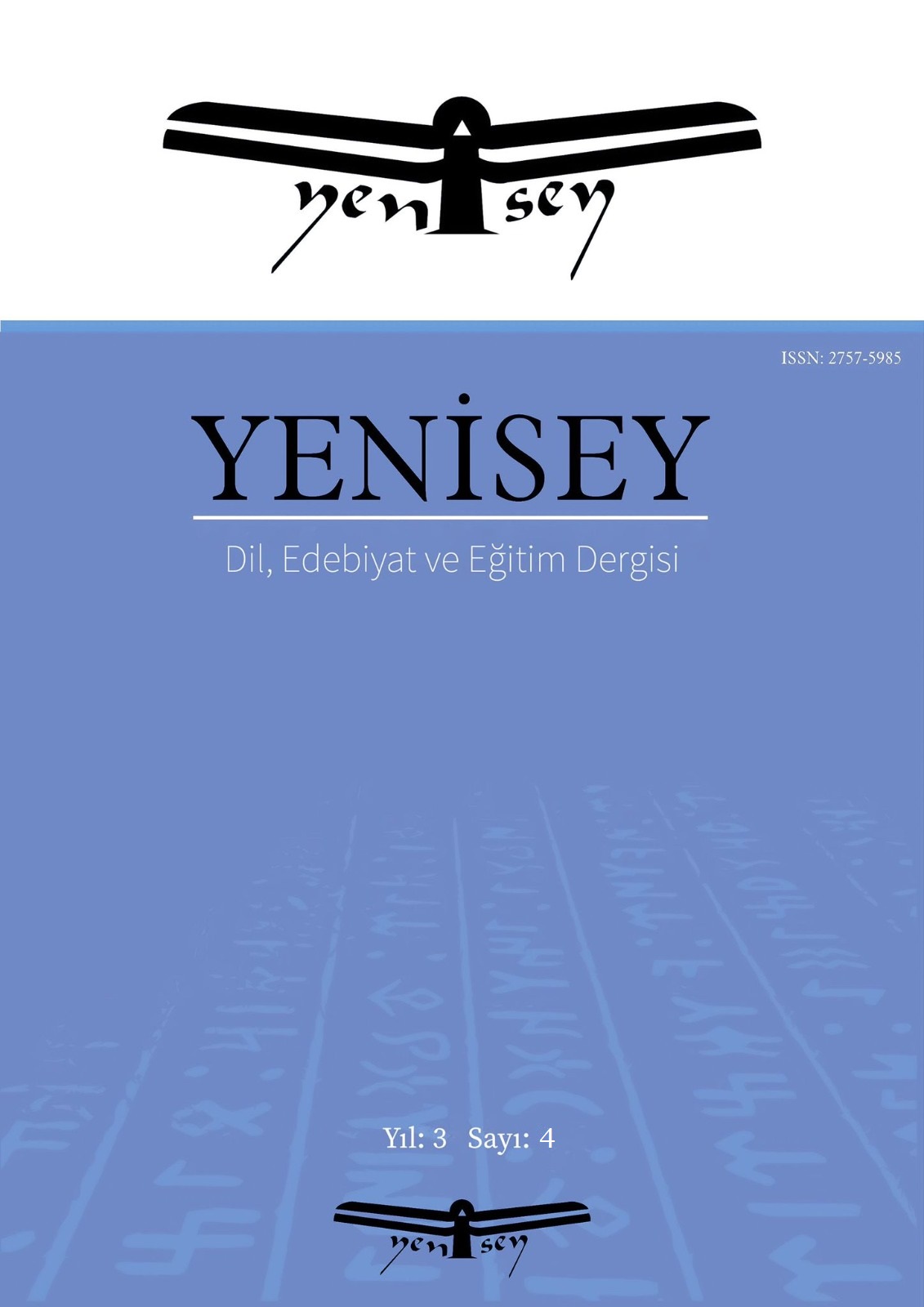Author :
Abstract
Türkçenin söz diziminde önemli bir yere sahip olan eylemsiler, temel yargı olan yüklemin yanında yan yargı oluşturmaları ve farklı anlam yapıları oluşturmaları bakımından önem arz etmektedir. Eylemsiler içerisinde yer alan sıfat-fiiller (ortaç), nesnelerin hareket niteliklerini karşılayan eylem şekilleridir. Sıfat fiiller, diğer eylemsi ekleri gibi fiilden isim yapım eklerine yakın bulunan ve geçici hareket adları oluşturan yapılardır. Eylemsilerin tümce içerisinde birçok farklı görevde bulunduğu bilinmektedir. Çalışmanın kapsamı ise daha çok sıfat-fiillerin anlamsal yönüyle ilgilidir. Bu bağlamda dilin şekilsel yapılarının anlamdan tamamen bağımsız olmadığı ve şekilsel yapıların da metnin anlamıyla örtüşeceği yönündeki düşünce, Türk dilinin önemli eserlerinden olan Atabetü’l-Hakayık üzerinden örneklerle açıklanmaya çalışılmıştır. Atabetü’l-Hakayık, 12.yüzyılda Edip Ahmet Yükneki tarafından kaleme alınmış ve güçlü, net iletisi olan bir eserdir. Eser halka iyi, erdemli, ahlaklı insan olmanın yollarını öğretmektedir. Metnin geneline bakıldığında eserin iletisi ile eserde bulunan sıfat-fiil yapılarının anlamları metnin iletisiyle uyuşmuştur. Bu da dildeki şekilsel yapıların metnin anlamından tamamen bağımsız olmadığını göstermektedir. Çalışmada bu sonuca ulaşmak için öncelikle Atabetü’l-Hakayık’ta bulunan tüm sıfat-fiiller bulunmuştur. Ardından tüm sıfat-fiiller Çiğdem Topçu (2011)’nun sınıflandırılmasından hareketle anlam kategorilerine ayrılmıştır. Bu sınıflandırmada bazı yeni başlıklar da eklenmiştir. Metindeki sıfat-fiil anlam kategorileri ise “Alışkanlık-İktidar-Güç”, “Diğerlerinden Ayırma-Zümre Oluşturma”, Diğerlerinden Ayırma-Yetkinlik-Elverirlik”, “Çıkarım”, “Beklenti”, “Benzetme”, “Karşılaştırma”, “Tasvir” ve “Tespit” şeklinde belirlenmiş ve örnekler verilmiştir.
Keywords
Abstract
Nonfinite verbs, which have an important place in the syntax of Turkish, are important in terms of forming sub-judgements and different meaning structures besides the predicate, which is the main judgement. Verbal adjective (participle), which are included in the nonfinite verbs, are forms of action that meet the movement qualities of objects. Verbal adjective, like other nonfinite verbs affixes, are structures that are close to verb-noun construction affixes and form temporary action names. It is known that nonfinite verbs have many different functions in sentences. The scope of the study is mostly related to the semantic aspect of verbal adjectives. In this context, the idea that the formal structures of the language are not completely independent from the meaning and that the formal structures will overlap with the meaning of the text is tried to be explained with examples through Atabetü'l-Hakayık, one of the important works of Turkish language. Atabetü'l-Hakayık is a work written by Edip Ahmet Yükneki in the 12th century and has a strong, clear message. The work teaches people the ways of being a good, virtuous and moral person. When the text is examined in general, the message of the work and the meanings of the verbal adjectives structures in the work are compatible with the message of the text. This shows that the formal structures in language are not completely independent from the meaning of the text. In order to reach this conclusion, firstly, all verbal adjectives in Atabet al-Hakayik were found. Then, all adjective-verbs were categorised into meaning categories based on the classification of Çiğdem Topçu (2011). Some new headings have also been added in this classification. The adjective-verb meaning categories in the text were determined as "Habit-Potency-Power", "Separation from Others-Creating a Group", Separation from Others-Competence-Efficiency", "Inference", "Expectation", "Analogy", "Comparison", "Description" and "Determination" and examples were given.
Keywords
- Arat, R.R. (1992). Atabetü’l-hakayık. Türk Tarih Kurumu Basımevi.
- Arat, R.R. (1992). Atabetü’l-hakayık. Türk Tarih Kurumu Basımevi. Banguoğlu, T. (2015). Türkçenin grameri. TDK Yayınları.
- Bayraktar, N. (2004). Türkçede Fiilimsiler TDK Yayınları.
- Bilgegil, K. (2014): Türkçe dilbilgisi. Erzurum: Salkımsöğüt Yayınları.
- Çağatay, S. (1948). Eski Osmanlıca’da Fiil Müştakları II. Partisipler, DTCF Dergisi, V.
- Demirci, K. (2010). Derin Yapı ve Yüzey Yapı Kavramlarından Ne Anlıyoruz?. Turkish Studies International Periodical For the Languages: Literature and History of Turkish or Turkic. 5/4, s.291-304.
- Ediskun, H. (1985). Türk dilbilgisi dil-sesbilgisi-biçimbilgisi-cümlebilgisi. Remzi Kitabevi.
- Ergin, M. (2009). Türk dil bilgisi. Bayrak Yayınları
- Hatipoğlu, V. (1969). Dilbilgisi terimleri sözlüğü. TDK yayınları.
- Herkmen, D. (2021). Kutadgu Bilig ve Atabetü’l-Hakâyık’ta Arapça ve Farsça Kelimerin Telaffuzu. Karadeniz Araştırmaları. XVIII/ 70: 449-467.
- Karabulut, F. (2009). Köktürkçenin Sıfat Fiilli Yapı Tipolojisi. Bilig. Kış (48), 91-118.
- Karahan, L. (1993). Türkçede Birleşik Cümle Problemi. Türk Gramerinin Sorunları Toplantısı, Türk Dil Kurumu, 22-23 Ekim.
- Karahan, L. (2010). Türkçede söz dizimi. Akçağ yayınları.
- Karpuz, H.Ö. (2000). Türkçede Zarflar- Türkiye Türkçesi Edebi Dilindeki Zarfların Yapısal ve İşlevsel İncelemesi. Ege Doğuş Yayınları.
- Korkmaz, Z. (2017). Dil bilgisi terimleri Sözlüğü. TDK yayınları.Müldür, F. (2016). Noam Chomsky’de Üretici Dilbigisi: Derin Yapı ve Yüzey Yapı Ayrımı. Kaygı Uludağ Üniversitesi Fen-Edebiyat Fakültesi Felsefe Dergisi. (27), 69-74.
- Salan, E. (2020). Zarf Fiil Eki, Zarf Fiil Midir? TYB Akademi Dil Edebiyat ve Sosyal Bilimler Dergisi. (29), 67-78.
- Soykan, Ö. N. (2006). Felsefe ve Dil Wittgenstein Üzerine Bir Araştırma. Bilge Kültür Sanat Yayınları.
- Topçu, Ç. (2011). Türkçede Sıfat-Fiil Kategorisi. [Basılmamış Doktora Tezi.] Sakarya Üniversitesi Sosyal Bilimler Enstitüsü
- Turan, Z. (2007). Türkçenin Yapım ve Çekim Düzeninde Yer Alan Eklerin Sınıflandırılması Nasıl Olmalıdır?. IV. Uluslararası Türk Dili Kurultayı Bildirileri II (24-29 Eylül 2000). TDK Yayınları. 1835-1844.





